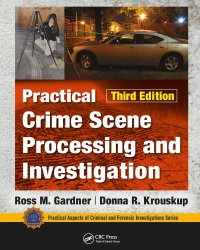
Ebook: Practical Crime Scene Processing and Investigation, Third Edition
Author: Gardner Ross M., Krouskup Donna
- Tags: LAW / Criminal Law / General., crime scene., criminal justice., forensic science., law enforcement., Crime scene searches., Criminal investigation., Evidence Criminal.
- Series: Practical Aspects of Criminal and Forensic Investigations Ser
- Year: 2018
- Publisher: Chapman & Hall/CRC Press
- City: Milton
- Edition: 3rd ed
- Language: English
- pdf
Every action performed by a crime scene investigator has an underlying purpose: to both recover evidence and capture scene context. It is imperative that crime scene investigators must understand their mandate—not only as an essential function of their job but because they have the immense responsibility and duty to do so.Practice Crime Scene Processing and Investigation, Third Edition provides the essential tools Read more...
Abstract: Every action performed by a crime scene investigator has an underlying purpose: to both recover evidence and capture scene context. It is imperative that crime scene investigators must understand their mandate—not only as an essential function of their job but because they have the immense responsibility and duty to do so.Practice Crime Scene Processing and Investigation, Third Edition provides the essential tools for what crime scene investigators need to know, what they need to do, and how to do it. As professionals, any investigator’s master is the truth and only the truth. Professional ethics demands an absolute adherence to this mandate. When investigators can effectively seek, collect, and preserve information and evidence from the crime scene to the justice system—doing so without any agenda beyond seeking the truth— not only are they carrying out the essential function and duty of their job, it also increases the likelihood that the ultimate goal of true justice will be served. Richly illustrated—with more than 415 figures, including over 300 color photographs—the Third Edition of this best-seller thoroughly addresses the role of the crime scene investigator in the context of:Understanding the nature of physical evidence, including fingerprint, biological, trace, hair and fiber, impression, and other forms of evidenceAssessing the scene, including search considerations and dealing with chemical and bioterror hazardsCrime scene photography; scene sketching, mapping, and documentation; and the role of crime scene analysis and reconstructionBloodstain pattern analysis and discussion of the body as a crime sceneSpecial scene considerations, including fire, buried bodies, and entomological evidenceCoverage details the importance of maintaining objectivity, emphasizing that every action the crime scene investigator performs has an underlying purpose: to both recover evidence and capture scene context.Key features:Outlines the responsibilities of the responding officer, from documenting and securing the initial information to providing emergency careIncludes three new chapters on light technology and crime scene processing techniques, recovering fingerprints, and castingsAddresses emerging technology and new techniques in 3-D Laser scanning procedures in capturing a sceneProvides a list of review questions at the end of each chapterPractice Crime Scene Processing and Investigation, Third Edition includes practical, proven methods to be used at any crime scene to ensure that evidence is preserved, admissible in court, and persuasive.Course ancillaries including PowerPoint® lecture slides and a Test Bank are available with qualified course adoption